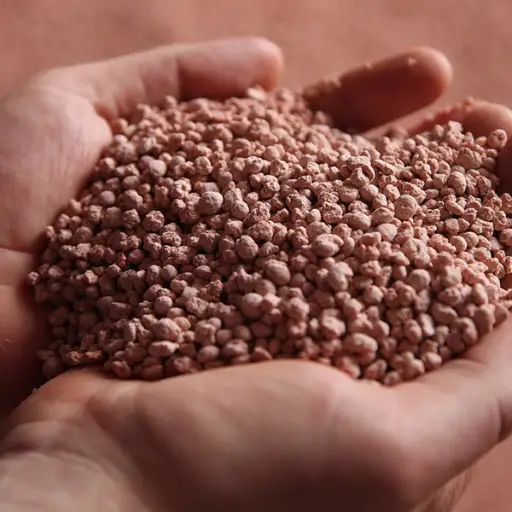Gardening enthusiasts and agricultural experts recognize fertilizers’ critical role in promoting healthy plant growth. Among the various formulations available, 18-18-18 fertilizer stands out due to its balanced nutrient profile. This type of fertilizer contains equal proportions of nitrogen, phosphorus, and potassium, each of which serves a unique function in plant development. Leveraging these nutrients effectively can significantly enhance plant vitality, improve crop yields, and optimize garden performance. In this blog, we will delve into the specific uses of 18-18-18 fertilizer, exploring how it can be employed in different gardening and agricultural contexts to achieve outstanding results.
What is the product description of 18-18-18 fertilizer?

Analysis of the nutritional composition
The 18 18 18 fertilizer is further based on the balanced mix, where nitrogen, phosphorus, and potassium are in equal concentration of 18 % each. Nitrogen is important for active leaf development and greening, thus improving the photosynthetic activities in the plants. Phosphorus helps establish roots and facilitates flower and fruit formation, enhancing the plant’s chance of successful reproduction. Potassium is needed for the general well being and hardiness of plants and assists in balancing the requirements of water and nutrients in the cells of the plant. Such a balanced composition allows the 18 18 18 fertilizer to be used effectively for an extensive range of crops and ornamental plants in order to promote even growth.
What does a balanced ratio of ingredients signify?
The balanced ratio of ingredients in the case of 18-18-18 fertilizer means that all of the three primary nutrients: nitrogen, phosphorus, and potassium are available in equal percentage of 18. Such equal distribution ensures that the plants receive more or less all the principal nutrients required in balanced quantity for their proper growth. Nitrogen is important for increases in the leaves’ green color and foliage’s growth. Phosphorus is concerned with the development of the root system, flowering and fruiting. Potassium helps improve the health of the plant and increase the plants’ defence against diseases and environmental stress. This balance also makes it possible to reduce reliance on a specific nutrient. This will help avoid the problems that over-reliance on a specific nutrient in fertilizers causes by having skewed growth patterns. Thus the plants are able to develop consistently and in a healthy manner.
What makes 18-18-18 water soluble?
The reason as to why the 18-18-18 fertilizer is soluble in water is that the characteristics of its formulation allow it to dissolve in water easily hence making nutrients instantly available for absorption by plants. This solubility guarantees that these essential nutrients are effectively utilized whether applied on the roots or leaves of the plants which enhances faster plant growth and achievements. The soluble characteristics of this fertilizer also make its usage possible through irrigation systems where nutrients are evenly spread across the growing area. This attributes makes it possible to quickly and efficiently utilize the fertilization process regardless of the method used for application.
How to apply fertilizer effectively?
Appropriate application methods in gardening
In case of garden fertilization, it is recommended to start with soil inspection. Before applying the recommended amount longer than average 18-18-18 fertilizer, read the package in order to avoid application intensity problems that could harm the environment. If a fast rain is guaranteed, the fertilization should be performed just before- to avoid leaching off the fertilizer. Adding fertilizer into the soil will also improve the effectiveness of the fertilizers, as it prevents leaching of nutrients. Avoid puncturing the soil in the hottest periods of the day to prevent high evaporation rates and dramatic pressures on plants. Use the repeated applications as required in the growth period, considering the condition of the plant and results of earlier soil tests.
What is the optimal time for application?
The best time to use the 18-18-18 fertilizer is usually influenced by the particular species of plants being reared and their respective growth periods. The fertilizer is normally applied at the start of the growing season as a booster for early growth and additionally at the mid growth period in order to help sustain growth. For most gardens, the middle and the second half of summer will be the best fertilizer application time. Timing is critical to meet plant needs since phosphorus and potassium shall be incorporated during the critical growth period. Further, it is essential to note the weather and not apply before it’s about to pour to avoid nutrient run-off.
When should 18-18-18 fertilizer be applied and how much of it is recommended?
Most of the time, the 18-18-18 fertilizer quantity is determined by the mathematical calculations of the area of the garden and the requirements shown on a soil test. As a rule of thumb, About 1 to 2 pounds of 18-18-18 fertilizer can be applied for every 100 square feet of the garden. One should follow the instructions given on the fertilizer bag so as to avoid applying excessive amounts which may result in burn of nutrients or adverse effects on the environment. The quantity to use may, however, be modified in relation to the findings of ongoing tests of the soil and the condition and the growth of your plants at that time of the year.
What crops benefit from this product?

NPK fertilizer 18-18-18 on turf and for landscaping
The use of 18-18-18 fertilizer is beneficial for maintaining healthy turf and landscapes. It is a balanced fertilizer that supplies equal amounts of nitrogen, phosphorus, and potassium, needed to encourage growth and greenness in plants. It improves root growth, greenness, stress, and disease tolerance on turf. This formula improves flowering and fruiting while enhancing growth on shrub and other ornamental landscape plants. It should be done in the active plant growth season to benefit from it but care should be taken in regard to the rate of application so that over-fertilization does not occur. As previously mentioned, regular soil analysis can assist in improving the application to the required landscape design.
How is growth in different types of plants encouraged?
The 18-18-18 fertilizer stimulates the growth of plants as it incorporates the essential macronutrients in equal ratio’s. Nitrogen can be particularly helpful in the development of the leaves and even the stems as well since it provides plants with vigorous and dense green traits. Phosphorus is involved in energy transfer within the vascular system and assists with the phloem and roots and in enhancing flowering. Potassium complements the plant’s overall performance by aiding in water management, disease, and adverse environmental conditions. In aggregate, these nutrients encourage an NPK ratio that encourages the growth of the plant, increases its yield, and makes plants adaptable to a variety of growing conditions.
Compatibility with different crops
Antonyi, these reasons seem worthy of consideration for supporting adoption of the fertilizer among different crops. However, several other factors such as soil fertility, water availability, seeds quality, and climate also seem to come into play in determining the fertilizer adoption levels, especially among farmers. 18-18-18 fertilizer is, however, conducive to a wide category of crops owing to its nutrient ratio. It is most advisable for crops having uniform growth and development patterns over the season. This fertilizer is often employed in minimum tillage systems for cereals, legume, as vegetables. So supply of these nutrients is for enough for healthy plants leaf, strong roots and more crops. Its usefulness, makes it adaptable to a variety of agricultural techniques, meeting the nutritional requirements of different crops and improving the ecology of the plants. Subsequent recommended actions maximize many benefits, allowing resolving specific nutrient needs at each stage of plant development.
What are the benefits of using 18-18-18 over other chemical fertilizers?

Comparing 18 18 18 and 20 20 20 fertilizers
Although both 18-18-18 and 20-20-20 fertilizers permit the equal distribution of nutrients, the varying nutrient concentrations will yield varied results when each formulation is applied. In general, both 18-18-18 and 20-20-20 fertilizers are considered balanced fertilizers since they contain equal proportions of nitrogen, phosphorus, and potassium; however, the 20-20-20 formulation contains a relatively higher nutrient concentration. This may be useful for crops that require a more substantial financial resource for nutrients, especially during seasons of rapid development or more intensive growth in controlled environments. On the other hand, 20-20-20’s concentration may also cause nutrient burn, thus care should be taken while applying this formulation and managing it more precisely to prevent harm to the plants. However, with the 18-18-18 there is a lot less risk of over-fertilization while doing an effective job of fertilizing a wide variety of crops. When it comes to general farming, this one them most reliable, dependable; most farmers prefer using this because there is no need of using a stronger fertilizer therefore, it is the most convenient one. So, in this case different farmers will have different priorities which suggest why they choose these two formulations over the other.
Benefits of using a water soluble blend
Fertilizers of the 18-18-18 blend type that are water soluble have a number of practical benefits that are helpful in crop management practices. To begin with, they offer instant requirements as the components are within reach of the roots and even the foliage of the plants, thereby expediting growth and enhancing health of plants. This is especially useful during the most crucial periods of crop growth when the demand for nutrients is very high. Also, water-soluble blends are compatible with an array of irrigation techniques, ensuring consistent coverage of the farm. Such versatility guarantees optimal use of resources and may substantially lower nutrient losses. Furthermore, due to the different requirements for different crops, these fertilizers can be easily manipulated and therefore, are a versatile option for any agricultural practice. Finally, use of water-soluble fertilizers lessens the threat of soil nutrient leaching such that soil health can be preserved for the long term and therefore, sustainable farming practices are encouraged.
What ingredient ratios are ensured in these fertilizers for balanced plant nutrition?
The ratio of plant nutrients in water soluble fertilizers is promotional in nature because the basic nutrients have been blended in doses’ proportionate to the requirements of the plants. Water-soluble fertilizer nutrients are completely water soluble and therefore do not leave any room for localized over or under application. Systematic application ensures that an optimum balance of nutrients is made available to the plant such that neither deficiencies nor surplus nutrients are experienced. In addition, the formulations are based on research and development and tested for the correct ratio for nutrients required throughout theof nutrients required throughout plant growth phases, healthy plants with good y,ield.
How does 18-18-18 support plant establishment?

Presence of essential trace elements in 18-18-18 fertilizer
The 18-18-18 Fertilizer formulation contains almost all of the primary macronutrients that promote balanced plant growth and establishment, along with some trace elements that are needed at critical stages for normal plant establishment. Such a combination includes important trace elements such as iron, zinc, manganese, and copper, without which the plant would not perform various biochemical processes. These trace elements assist in enzymatic processes, chloroplast formation, and the general metabolism of the plant. With these nutrients optimized, plants are able to develop strong root systems that help them absorb more nutrients and make them more resistant to environmental stresses. By using these important trace elements, 18-18-18 achieves its aim of facilitating proper seedling development and growth during the first and most critical stages of the plant’s life.
Urea in plant nutrition
Different studies indicate that when plants are deficient in Nitrogen then Urea is a very good nutrient supplement rather than other nitrogenous fertilizers. Urea is very cheap and is preferred in many countries. When urea is put in soil, it hydrolyzes by urease thus ammonium carbonate is produced in the plants. So, this nitrogen is always released in a gradual manner which is essentiagradually,bolism, and chlorophyll synthesis as well as osynthesis. In additi, and cheaper and more efficient for growing crops on a large scale since its nitrogen content is greater than that of other forms of nitrogen fertilizers. Subsequent application of Urea allows the various crops to maintain a robust supply of nitrogen, leading to a substantial increase in growth and production yield.
Improving soils with 18-18-18
Improving soils with the above-mentioned fertilizer blend has a reasonable proportion of nutrients necessary for advancing plant and soil productivity. However, from my understanding, providing equal amounts of nitrogen, phosphorus and potassium assures that plants get,t a wide variety of nutrients essentialvarious. Nitrogen helps in the development of leaves, and phosphorus helps in the growth of roots and flowers, whereas potassium increases the gen. In contrast, potassiumant and its ability to fight diseases. I carried out the above procedures and applied this blend on my field. I managed to observe improvement in soil texture, nutrient holding capacity, and promotion of microbial activities, which are essential factors for plant growth and enhancement of agricultural productivity.
Reference sources
- Romeo 18.18.18 Fertilizer – This source discusses the balanced nutrient composition of 18-18-18 fertilizer and its application during various growth stages of plants.
- Shur-Crop 18-18-18 Fertilizer – This product page highlights the use of 18-18-18 fertilizer as a pre-plant fertilizer for gardens, pastures, turf, and ornamentals.
- Nutrient Express 18-18-18 Fertilizer – This source explains how 18-18-18 fertilizer enhances nutrient absorption and efficiency, improving crop production and quality.
These sources should help validate the feasibility and benefits of using 18-18-18 fertilizer for your readers.
Frequently Asked Questions (FAQs)

Q: What can 18-18-18 fertilizer be applied to?
A: This 18-18-18 fertilizer is a multipurpose balanced fertilizer developed specifically to enhance plants’ vegetative growth and strengthen roots for a wide range of plants and shrubs including ornamentals and those used in gardens.
Q: What are the benefits of planting different plants in greenhouses?
A: This stronger NPK fertilizer greatly enhances the probability of vigorous vegetative growth. Its balanced ratio, ideal for greenhouse settings, maximizes plant health.
Q: Does bird gardening need 18-18-18 fertilizers?
A: Yes, 18-18-18 fertilizer is beneficial for bird gardens as it helps plants that lure in the birds thrive, thus increasing the biodiversity within the environment and the overall ecosystem.
Q: How much of 18-18-18 fertilizer do i need to apply per acre?
A: A specific recommended dose is not easily available, however the commonly quoted range is between 200 to 400 lb per acre but this is also subject to soil fertility and the needs of specific plants. Refer to product depictions for utmost effectiveness.
Q: What are the forms available for 18-18-18 fertilizers?
A: Drip or spray options can be chosen but yes, it is available in plenty forms including 18-18-18 fertilizer in liquid and solid formulations. It is best to choose one which suits the method of application, such as through drip or regular spreading.
Q: What elements are important in 18-18-18 for establishment of plant in fertilizer?
A: Elements could be: nitrogen, phosphorus and potash which are necessary for root initiation and the vegetative growth of the plant.






